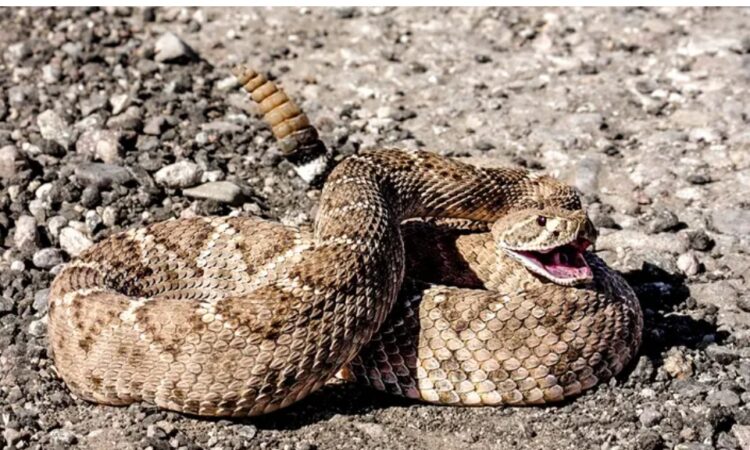
Imagine you’re hiking on a hot day when you spot something coiled on the trail: a rattlesnake, shaking its tail at you in warning. You stand stock-still until it quiets down and slithers on its way.
But what if the snake hadn’t been considerate enough to warn you of its presence? Last month in Texas, a woman reported that a snake simply fell from the sky and started attempting to bite her—while the hawk that had dropped it also attacked her.

While the altercations aren’t typically so dramatic, each year venomous snakes bite an estimated 7,000–8,000 people in the United States. And with climate change, that number may be increasing, recent research suggests. Scientists at Emory University have calculated that for every degree Celsius that the temperature rises, snakebites rise by 6 percent (perhaps because both snakes and humans change their behavior in the heat).
So what should you do if you do get bitten by a snake? Are you supposed to cut out the poison? Ice the wound to decrease swelling? Tie a tourniquet? (Spoiler alert: no, no, and no—but more on that later.) There’s a lot of confusion and misinformation out there—but the real answer to this question is surprisingly simple.
It’s worth saying up front that if you are bitten by a snake, you should call Poison Control as soon as you can. (The number is 1-800-222-1222.) They are the experts in snakebites. They can advise you on the severity of your bite and how you should respond—whether you need a helicopter evacuation, for instance—and direct you to the nearest medical center that can treat a snakebite, and even alert the center that you’re coming. (If you require immediate medical assistance—say, you are having trouble breathing—of course call 911.)
There are, however, some steps and statistics that are worth knowing just in case you do find yourself in a situation with a snake, and you’re panicking—or, if you end up in the wilderness with a snakebite far from cell service. Even if you are more of an indoor person, you might be surprised to learn that your impression of snakebite emergencies from pop culture is a little wrong.
First: If a snake bites you, take a deep breath and remind yourself that you’re going to be OK, said William Rushton, a professor of emergency medicine at the University of Alabama at Birmingham. Out of the thousands of people bitten each year in the United States, there are, on average, fewer than five deaths. You’re far more likely to die from a wasp or bee sting.
There are several reasons why snakebites, at least in North America and the Global North, aren’t as deadly as we’ve been led to believe. First, a quarter of bites from most venomous snakes found in the U.S. are “dry bites,” meaning the snake doesn’t actually inject any venom into the body. Snakes evolved venom to help them digest prey—and snakes are smart enough to know we’re not dinner. “They don’t want to use up their venom on you. They just want you to go away,” said Saralyn Williams, a professor of emergency medicine at Vanderbilt University Medical Center.
More importantly, our treatments for snakebites are incredibly effective. “In general, we have the experience and technology to get people through snakebites,” Rushton said. While some snakebites in the United States do result in long-term injuries, like losing a finger, up to 90 percent resolve completely. (Unfortunately, dying from a snakebite is far more likely in Southeast Asia and parts of Africa. That’s partly because the snakes themselves are more dangerous. But the bigger factor is lack of access to lifesaving medical care.)
Yes, it’s still unsettling—and an emergency—when a snake sinks its fangs into you. After you calm down, it’s time to get yourself to the hospital, Williams said. Even if you feel fine, or aren’t sure if the snake that bit you was venomous, it’s important that you access medical care as soon as possible. Some bites, particularly those from coral snakes, don’t cause symptoms right away. Don’t try to drive yourself unless you have no other option. After a snakebite, you’re likely to experience a lot of pain and may even feel dizzy or nauseated, so the safest transportation options are to call 911 or have someone else drive you, Williams said.
But what if you’re far from emergency attention? As a hiker and a trail runner, I’ll sometimes find myself upward of 10 miles from even the most remote country roads. More than once, I’ve narrowly avoided stepping on rattlesnakes in the backcountry of arid California or southern Oregon. Each time I see one coiled on the trail, I think through how I’d respond if one did strike me—and before researching this article, would invariably come up blank.
One of my most important takeaways is that while there are a few things you can do to treat the early symptoms of a snakebite, the first-aid step that really matters is getting yourself to medical attention as quickly and as safely as possible (and to get to cell service to call 911 or Poison Control if that is not immediately an option). The best way to do so depends on a lot of different factors, Williams said.
If you’re hiking with a group, and are within a few hours of help, your best bet may be to lie low. Find a shady, safe spot to rest while a member of your party goes to get help—whether that’s someone who can help carry you out, a park ranger, or a vehicle to get you to the emergency department, Williams said. (It’s much easier to navigate backcountry emergencies of all sorts if you are hiking with a buddy.)
Stay as still as possible—movement will exacerbate pain at the bite site. Your first symptom will likely be swelling; to get that down, elevate the bite site to heart level. Swelling can make it difficult for health care providers to administer antivenin—medicine that neutralizes snake venom—if it turns out you need it, Williams said. But it’s also important that you don’t ice the wound and don’t take ibuprofen or any other NSAIDs, which can increase bleeding. (Products that contain acetaminophen, such as Tylenol, are okay for all kinds of snakes, she added.)
While you’re lying low, take off any constricting clothing, jewelry, or watches. Definitely don’t try to tie a splint or tourniquet or compress the bite in any way, especially if you’re located in North America. While compression pads and bandages are recommended internationally by the World Health Organization and by health authorities in Australia, it takes training to administer these devices correctly without damaging the muscles and tissue.
Plus, the evidence for their efficacy in bites from North American snakes is weak. (The title of a Clinical Toxicology editorial on the matter: “Pressure Bandaging for North American Snake Bite? No!”) Tourniquets, which are tighter than compression pads, aren’t recommended anywhere. “I’ve seen more dangerous consequences from tourniquets than from snakebites,” Williams said.
If you’re many hours from the nearest trailhead, alone, or have a more severe bite, try to get yourself out. It’s going to suck, but you’ll likely be OK, Rushton said. If someone in your party is able, have them carry you.
That brings me to my next takeaway: While treating snakebites is time-sensitive, it’s not blowing-through-red-lights time-sensitive. “Even if it takes you 24 hours to a health care facility, your chance of death from a snakebite is still going to be exceptionally low,” Rushton said. If it turns out that you do need antivenin, sooner is better than later. But there is no hard-and-fast rule about how late is too late.
There are steps you can take to prevent a severe snakebite. Dress properly for outdoor activity—boots and long pants can make a huge difference, Rushton said. “The people I see getting bit hiking are almost always wearing flip-flops or sandals,” he said. Don’t stick your hand or foot into dark spaces, like cracks between rocks.
Be especially careful crawling into tunnels and caves—doing so can put you at risk for a bite on the face, which is much more dangerous than a bite on a limb. And definitely don’t try to handle or antagonize snakes—it sounds obvious, but enough people try this that it needs to be mentioned, Williams said. Last, stay away from snakes even if they appear lifeless—snakes have a biting reflex that lasts for hours after they die.




